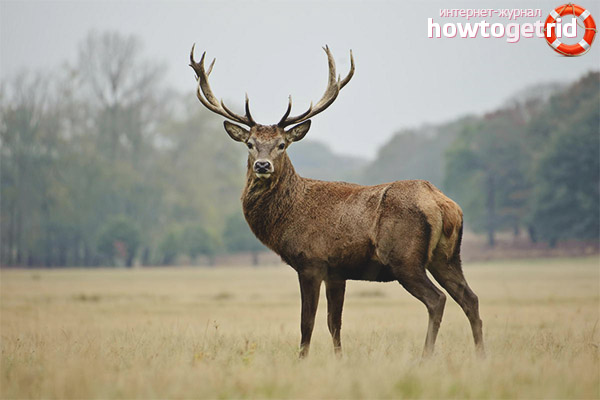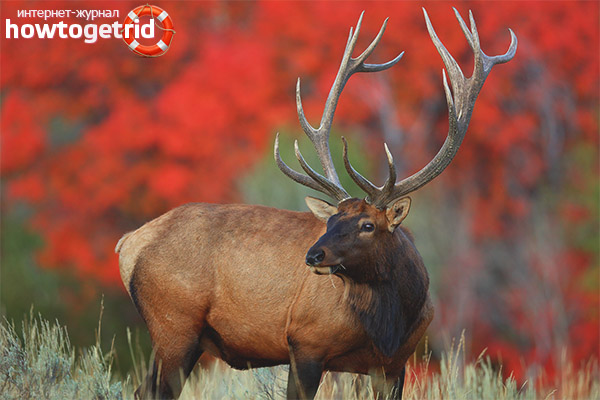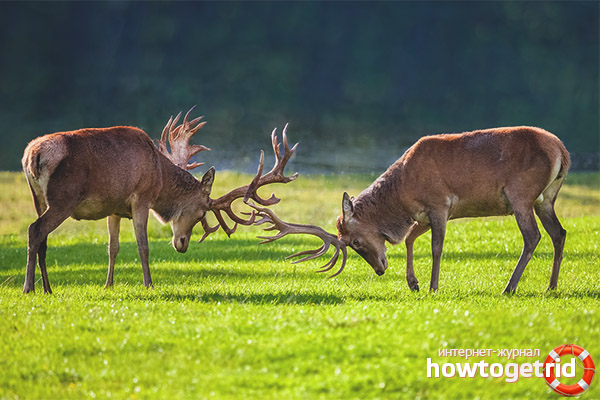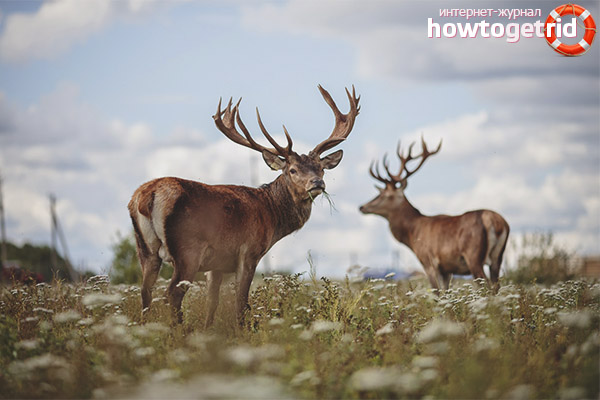The content of the article
The red deer refers to a cloven-hoofed animal, which belongs to the deer family. The individuals of the presented pedigree variety are distinguished by their external data, beauty and overall features. Each animal has its own distinctive characteristics, it all depends on the age category and gender. Individuals may have branched or strict neat horns. Their size also varies. But let's not get ahead of ourselves, having studied the most important features in the next order.
Description
- This species includes many subspecies (more than fifteen), which determines the characteristics of a particular individual. Animals differ not only in external data, but also in size, lifestyle, behavior and other features. However, a common feature is still wool, which does not become spotty in the summer. Also under the tail is a whitish speck. In the animals presented, the horns consist of several processes that give individuals nobility and create a kind of hat on their heads.
- Depending on which subspecies a particular individual is assigned to, its features differ. Some varieties can be extended in length along the body up to 2 m or more with a mass of about 280 kg. Others, on the contrary, are compact, grow on the body up to 1.4 m. And weigh 100 kg. The pigmentation of the coat is mostly of the same type, consisting of yellowish, brownish, grayish tones.
- Representatives of male gender have branched and voluminous horns, but this does not prevent them from looking neat. Female representatives of the horns family do not have at all. The ears are oval in format, the tail is shortened. When babies are born, they are immediately endowed with spotting. However, over the life cycle, this pigmentation disappears. The eyes of the discussed individuals in the dark become reddish or orange.
- In the back section of the hips, whitish marks are present in the tail region. This feature distinguishes deer from the like-like. The presented trait is necessary so that individuals from the pack do not lose comrades when living in forest parts. When an animal grows up, its spot increases in area, and also becomes yellowish-orange by pigmentation.
- It makes sense to consider the duration of these individuals. If everything is in order with their health, then the representative of the species will reach thirty years or more. However, if we consider accommodation not in captivity, then this period is significantly reduced. The animal hardly survives to the thirteenth year. It has been proven that the female half lasts longer than males.
Behavior
- The animals of the breed group under discussion are characterized by living in flat areas. However, some can climb into dense forest stripes and still feel comfortable. They are characterized by a settled existence in the selected territorial area. They try to stick to living in groups, which often concentrate twelve individuals and even more. Despite the decent overall features, these animals do not require a large area. 300 ha are quite enough.
- Some representatives of the species can settle in the mountains, as well as travel decent distances for food. At a time, about 130 km pass with the family respite. In the winter, they look for places to stay that are not snowy or snowy, but moderately. Go from place to place, without rushing. The whole process takes a couple of months.When the end of spring comes, the animals return to their places. They do not like heat, so they take refuge and put off their wakefulness at dusk.
- With summer heat, deer move to water sources in order to somehow cool their body. Wet, they get out to land, go to graze, then cool again in water. These are the main actions performed by members of the family. By the winter season, individuals decently get tired due to lack of food in the autumn season. To get food, they row snow. Wells are obtained in the same way so that you can lie down and rest.
- The herd includes individuals of different gender and age. However, only a mature female leads the group. Of course, the male representative of the family can also stand at the head, but this is extremely rare. When a group is headed in this way, the female does not take responsibility for and subjugation of more than six individuals. In the springtime, each individual representative of the species is looking for more comfortable living conditions. Over time, he and all the others disperse, and closer to the cold weather they come together again.
- The year originates around the middle of the autumn season. When it comes to an end, offspring are born. It also joins adult animals. In young animals, horns grow when the life cycle approaches one year old. Initially, there are no branches, the horns are straight and not very beautiful. When the spring season begins, or rather its middle is nearing, the horns are discarded by individuals. Further, the latest sections responsible for branching appear on them. Of course, with the course of the life cycle, they become larger.
Area
- These family members cannot be called rare. Rather, they are moderately common. Distribution is diverse, which cannot be said of other members of the family. Often individuals live in the west of European countries, they are also found near Algeria and Morocco.
- According to the climate, Scandinavia is suitable for animals, or rather its southern part. Not without Tibet, Mongolia with Afghanistan. Meet family members in North America and China. Some species are so rare that they are found in Australia, as well as Chile with Argentina and other similar regional zones.
- Of course, there are representatives of the family in the Caucasus. They live near the forest strips in the summer, to be able to take refuge in shady areas. They also need water sources for drinking and cooling. In the process of choosing a zone for existence, individuals try to give preference to sites that concentrate different herbs.
- Representatives of the species of the corresponding climatic zones descend into meadow plots with green grass. They can go up and up, the main thing is that there is a decent feed base, which will cater to the needs of all members of the pack. Some of the animals require poplar to live, others live in shrubbery, while others like beech thickets.
Diet
- All representatives of this species eat exclusively plant-based foods. At the same time, the daily diet of animals is saturated with buds and foliage of various plants. The considered individuals often regale themselves with annual shoots of deciduous shrubs and trees.
- It is noteworthy that with the onset of the warm season, the diet of these individuals often includes mushrooms, berry crops and various mosses. Those animals that live near the coast often enjoy the algae thrown ashore. Such food can be considered a favorite among representatives of this genus.
- Among other things, the presented individuals often eat branches of deciduous trees. Among these, you can distinguish willow, oak, ash, wild pear and apple tree. It is precisely various cereal crops that play a very important role in the diet of the animals presented.It is this kind of food that is very important for animals at the time of spring.
- There are times when there may simply not be enough food supply for individuals. In this case, the animals under discussion most often when eating begin to give preference to pine needles. Only problem is that such raw materials are saturated with resin. Because of this, deer often have disruptions in the activity of the gastrointestinal tract. Mostly weak and young individuals suffer greatly from this.
Enemies
- Regardless of the type of animals in question, the main and natural enemy of these are wolves. Only a pack of wolves will be able to attack a young and healthy deer; one predator simply will not catch up with an obstinate and fast animal.
- When the wolves attack, the presented individuals begin to fight back with very powerful hooves. Mature and large males are also defended by powerful horns. In addition to wolves, the animals in question are often hunted by wolverines, tigers, bears, leopards and lynxes.
- In most cases, it is weak and immature young individuals who become victims. Sick adult deer can also become them. As if wildlife did not put everything in its place, the greatest danger to the artiodactyls discussed is precisely the person.
- In the modern world, in many territories where the presented animals live, hunting is completely prohibited. The bottom line is that among the deer there are individuals of a rare species. Therefore, such artiodactyls are guarded and protected.
- Poachers continue to prey on the non-ossified horns of the animals in question. The problem is that this part of the body is very much appreciated. In addition, such horns have high healing properties. It is noteworthy that in the Altai deer have long been bred for these purposes. Animals are kept in special pens.
- Based on such raw materials, local medicine men prepare extracts based on water or alcohol. Ultimately, the finished medicine is used in pharmaceuticals. This composition has adaptogenic and tonic properties.
- Even in the Soviet Union, such a medicine was officially patented. The tool is successfully used for severe overwork and asthenic syndrome. The healing drug is able to withstand neurasthenia and arterial hypotension.
Breeding
- It is interesting that the considered individuals reach puberty at about 2 years. After mating, on average, the female continues to bear offspring for about 240 days. Often young growth is born an advantage in late spring and mid-summer.
- It is worth noting that before childbirth, females of this species are separated from the herd. At the same time, the animal tries to climb into safe and dense thickets. Most often such places are coastal zones that are located near rivers and streams.
- Before the offspring is born, the female carefully selects a suitable place, after which she begins to equip it. Then, in a secluded corner, only one deer appears in the light of the bowl. In extremely rare cases, there is twins. In this case, the mass of the newborn is about 10 kilograms.
- Already at an early age, the baby has a characteristic spotty color. The advantage of this color is that it greatly helps the fragile individual to hide from predators in the wild. In this way, offspring are saved from attacks in the first weeks of life.
- It is interesting that among males of the species under consideration, individuals are often found in which horns do not even grow with age. Because of this feature, they cannot take part in traditional battles. Such deer do otherwise. They enter other people's harems and mate with females.
- At the age of one month, young cubs begin to eat already on their own. However, in addition to grass, deer continue to feed on breast milk. This period can last up to 1 year.Active growth of offspring lasts up to 8 months. Then individuals only grow up to 6 years old.
At present, the numbers of these individuals are not in danger, since they are common in national parks. In some areas, such animals are even more likely to harm the environment. The problem is that they prevent rare plants from recovering. In South America, by contrast, they try to exterminate such animals. They interfere with the development of other species of rare deer.
Video: red deer (Cervus elaphus)













Submit